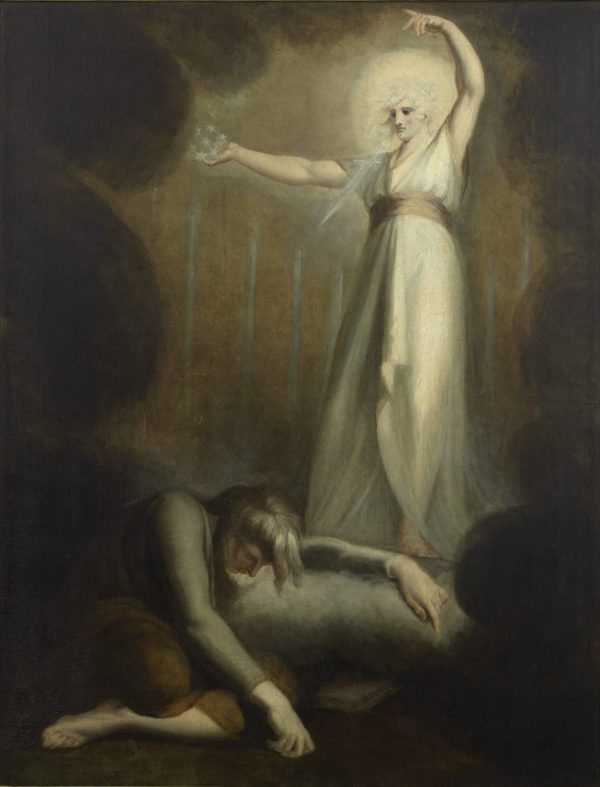St. John’s vision of Christ and the seven candlesticks from the apocalypse, 1796
Oil on canvas, H. 1.32 m; W. 1.01 m
Provenance: Commissioned in 1796 for Thomas Macklin’s Holy Bible.
Macklin Sale, Cox, Burrell and Foster, 5 - 10th May 1800.
- J. Knowles, Life and Writings of Henry Füssli, 1931, Vol. I, p. 194.
- Arnold Felderman, Johann Heinrich Füssli, 1927, p. 53.
- G. Schiff, J.H. Füssli, Milton-Galerie, 1963, p. 16-18.
- G. Schiff, Johann Heinrich Füssli, 1973, vol. I, p. 172-173, no. 931.
- G. Schiff & P. Vitto, L’Opera Completa di Füssli, 1977, no. 95.
- D. Weinglass, Collected English Letters, 1982, p. 138-9, 147, 148-9, 154, 160-1, 175, 176.
- D. Weinglass, Prints and Engraved Illustrations by and after Henry Füssli, 1994, no. 41.
Füssli was an ordained Zwinglian minister – a career choice imposed upon him by his father who was adamantly opposed to him becoming an artist. Many of his drawings through the 1770s were based on the Bible; his very first painting (re-discovered in 1975) depicted Joseph Interpreting the Dreams of the Butler and the Baker (1768). Yet, Füssli’s ‘scriptural’ works represent only a very small proportion of his estimated 2,300 productions, and the choice of biblical subjects was frequently highly unconventional, particularly in his designs completed before his departure for Rome for Willoughby’s Practical Family Bible (1772), e.g. Ahab’s Sons Slain by the Rulers of Samaria and Jonah’s Indignation. Füssli’s proposed alternative to the present painting (4 April 1796) was ‘the Pope Spitting Frogs’ from Revelations, 16:13.
This painting was executed in 1796 for Thomas Maclin’s Holy Bible, published in six volumes in 1800 with large-scale engravings by Bartolozzi, Fittler and Sharp etc. after Kauffman, Northcote, Opie, De Loutherboug and others.
Füssli’s subject, Christ appearing to St. John as he lies in a mystical trance, and commanding the Evangelist to record this and other visions in a book and send it to the seven churches of Asia Minor (Revelations, 1:12-17), is an uncommon theme in post-Renaissance art, although Benjamin West also executed a sketch of the same theme for Fonthill in 1797. Füssli depicts the scene with fidelity to the text: the untraditionally beardless figure of ‘one like unto the Son of man’ stands majestically amid the seven candlesticks (v.13), which like the seven stars he holds in his right hand represent the Asian churches (v.16); he wears ‘a garment down to the foot’ with a ‘golden girdle’ under his breast (v.13). His head with its ‘hair white as snow’ (v.14) is surrounded by an aureole of light, bright as ‘the sun shining in his strength’, and a ‘sharp two-edged sword’ projects from his mouth (v.16).
Füssli derived the composition of the present painting ‘almost without alteration’ from an etching illustrating Johann Rudolf Wirz’s Romae animale exemplum (1677). But this leaves out of account the closer similarities between Füssli’s composition and Hans Burgkmair’s more expressive woodcut on the same subject (1523), which was also Wirz’s point of departure. Another pertinent source with which Füssli was undoubtedly acquainted, also based on the Burgkmair prototype, was the woodcut in Tobias Stimmer’s Bible.
